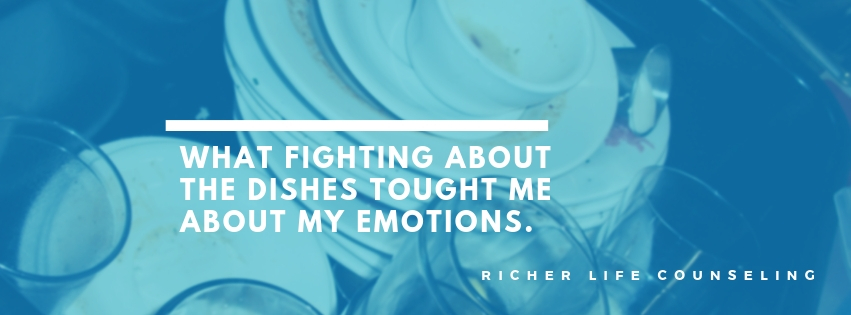When I was in grad school, I found myself getting so angry when I would get home after a long day. Why was I upset the dishes still dirty, still sitting in the sink! I could feel my blood starting to pump more and more; I could hear my voice starting to rise as I asked the question (that was not really a question) “Why didn’t you do the dishes as I asked?”
You guessed it, getting angry and lashing out feels good at the moment but never lead to a productive conversation. Let me be honest it would lead directly to a fight. I started to wonder why I was getting so upset over the dishes? I like a clean house as much as the next person, but I was putting a lot more emotion and meaning to “doing the dishes” than I should have. Why?
Primary and Secondary Emotional Responses
Then I found out about primary and secondary emotional responses. I have always said that there is a logic to emotion, and you have to learn to understand that logic. For me, primary and secondary emotional responses helped me develop a more profound sense of myself, my husband, and my clients.
Emotions are complicated, and before you can start to understand their logic, you must know what you are feeling. So step one is working through your feelings by labeling them, understand what it physically feels like when you are experiencing them.
Emotions combine with each other and complicate each other. We can also experience loads of different emotions within just a few seconds.
Primary Emotions
Primary emotions are the first emotions that you feel for any given event. Secondary emotions are feelings you experience after primary emotion. Secondary emotions usually are more intense emotions that push people away or protect yourself in some way. While primary emotions and usually more uncomfortable by nature and require some vulnerability to experience.
Secondary Emotions
Secondary emotions usually are emotions that push people away and can include: angry, frustration, irritation, withdrawing, anxiety, and fear. Any feeling can be a primary or secondary emotion, the key thing to remember: are secondary emotions push someone away or protecting a more profound emotion that might be too difficult to share.
Look back at my anger at the dishes was my display of my secondary emotion. Lets look at the logic behind why I was getting angry.
I was in the middle of grad-school, with homework, presentations, group work, interning 25 hours a week with no pay, and holding down a 40 hour a week job. I felt stretched thin and overwhelmed. Did I share this vulnerable emotion of feeling overwhelmed? Did I even know that is what I was feeling? I had little awareness much like most of us do of my deeper feelings. It would be hard to share with someone that I was are feeling overwhelmed and needed help (or at least it is for me).
So instead of sharing my primary emotion, I let my secondary emotion take control, and I would pick a fight after a long day. Becoming angry did not lower my feelings about being overwhelmed. It did, however, preoccupy me, so I did not have to deal with feeling overwhelmed. So in a way expressing anger help me deal with feeling overwhelmed yet the problem is it was not working very well.
My primary emotion of feeling overwhelmed was point me in a direction. That emotional need was:
- “I need help.”
- “I wanted to come home and relax and talk about my day.”
- “I wanted to get support from my husband.”
I was getting the opposite by not sharing my feelings.
I had to look at myself and see that I wanted, and what I wanted was a connection and help with all that I was doing. When I learned this about myself, I had a choice to be vulnerable and shared how overwhelmed I felt, or I could continue to fight and be angry. So the next time I came home and the dishes were not done I chose to be vulnerable. I said something like, “I am feeling angry because the dishes are still in the sink, but I know it is because I am so overwhelmed. I wanted to come home and spend time with you tonight and not worry about doing chores.”
You know what happened when I owned my primary emotion and shared that need? My husband started helping out around the house more; he made sure the dishes had been washed and put away. He said he had no clue that I was feeling overwhelmed and wanted to help.
Recognizing your primary and secondary emotions is the first step in building a healthy relationship. You must look at yourself to see what your feelings are pointing to and then learn to ask for that need to be met. Every situation is different, and sometimes you are not able to be open with your primary emotions, and that is ok. What I tell my clients and what I believe is its about understand whats going on with you and choosing how to share it. Not just getting angry at the dishes because you are unaware of what is going on.
- Table Topics - June 25, 2020
- How to Apologize - June 11, 2020
- What is stonewalling? |TheRicher Marriage Show - June 5, 2020

